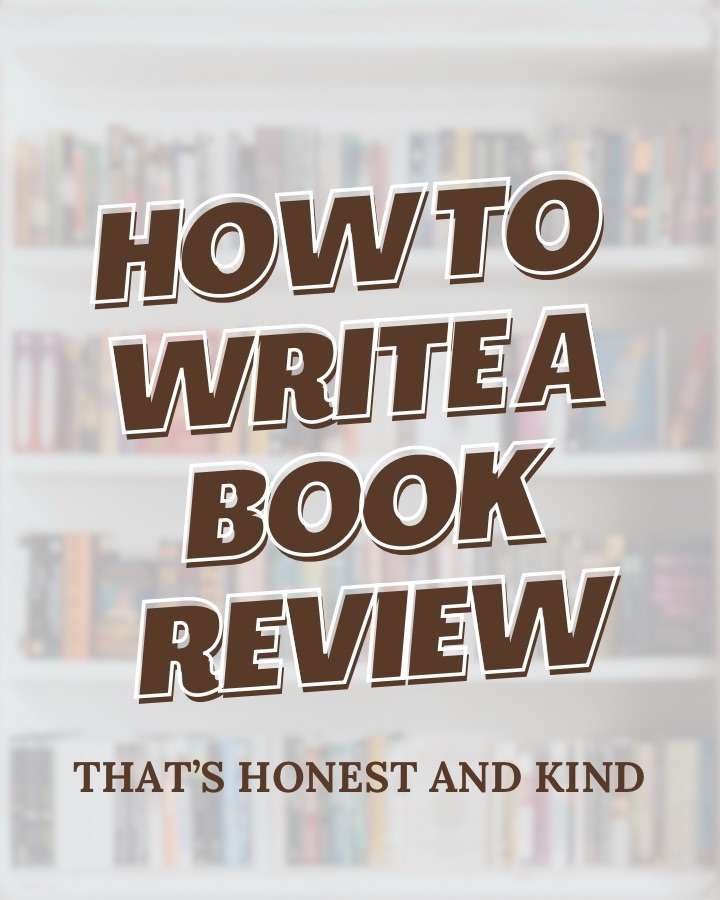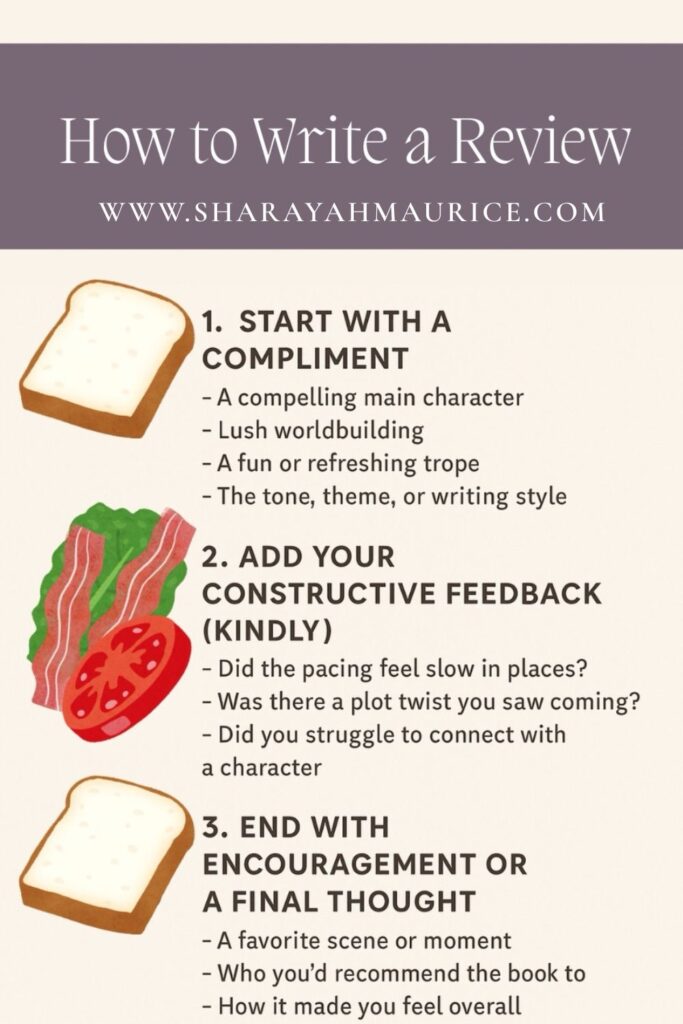Yes, there is a right way to write a book review, and in this post, I’m going to give you the perfect framework to help guide you in writing a helpful, insightful, and fun to read book review every time.

As an Amazon Associate, I earn from qualifying purchases. Thanks for supporting my blog!
Whether you’re reviewing your latest no-spice fantasy romance favorite or diving into a new genre, writing a book review can feel intimidating. Did you know that there is actually a framework that you can use that makes writing book reviews super simple? In this post, I’m breaking down the framework that I use in every review, ensuring that my book reviews are helpful, insightful, and fun to read.
Before we dive into how to write a book review, let’s talk about why they matter—especially for indie authors.
Why book reviews are so important
Book reviews aren’t just for readers looking for their next read—they’re lifelines for authors, especially those publishing independent. (like me!)
Here’s why your review makes a huge difference:
- Social Proof: Reviews act like word-of-mouth recommendations. When readers see a book has dozens (or even just a handful) of thoughtful reviews, it signals that the story is worth picking up.
- Visibility & Algorithms: Amazon, Goodreads, and other retailers prioritize books with more reviews. Did you know that once a book reaches fifty reviews on Amazon, Amazon will start pushing that book into the list of books they recommend to readers? A simple review can help that book show up in searches, suggestions, and “readers also enjoyed” lists. (Y’all I cannot tell you how much I am DYING to hit 50 reviews on Amazon–I’m SO close! So, if you’ve read any of my books, PLEASE help an indie outtt)
- Confidence Boosts: For many indie authors, reviews are one of the few ways they know their book is reaching readers. Your positive review might be the encouragement they need to keep writing. This support means everything! I did a whole post on how to support indie authors, so when you are done reading about how to write a book review, check it out!
Aren’t Reviews Just for Readers?
Some people argue that reviews are meant only for other readers—and not for authors. And while it’s true that reviews help readers decide what to pick up next, that’s not their only purpose.
For indie authors especially, reviews provide essential feedback, encouragement, and even insight into what’s resonating with their audience. No, you don’t need to write your review for the author—but it’s okay to acknowledge that they might read it. Thoughtful, kind feedback helps authors grow, and genuine praise reminds them why they do what they do.
This is also why I, personally, write book reviews. As an author, I have a unique view point that can be very helpful to other authors. Sure, I can volunteer to be an author’s critique partner, or sign up to be an alpha or beta reader for an author, but honestly, I don’t have the time to commit myself to something like that. I’m a reader before I was ever an author, and just because I published a few books, doesn’t mean I can’t leave reviews anymore. When my reviews can be helpful to authors and other readers, I’m going to leave them.
So if your review ends up encouraging both future readers and the writer behind the story? That’s a win-win. Alright, now that you know why you should leave book reviews, let’s talk about how.
How to Write a Book Review
First of all, it’s helpful to start with the basics. When people read your review, they need to know what book you are reviewing! Here are some helpful things to include right at the start.
- Title & Author
- Genre (especially helpful if it’s a subgenre, like cozy fantasy or romantic portal fantasy)
- Trigger/content warnings (if applicable)
- Your star rating (optional, but helpful if you’re posting to Goodreads or Amazon)
- Publishing info (again, optional, but I like to also include this info that way readers who are looking to support more indie authors know which books to pick
- Spice rating (if you have a chili pepper system you use)
The template that works everytime
Now it’s time to get to the meat of your review. I use a template for every book I review, and it is called the compliment sandwich. This template is especially helpful for books that I enjoyed, but maybe had some things I didn’t love.
The template is simple:
- Start with what you liked
- Mention something that didn’t work for you (kindly)
- Finish with a positive takeaway or final thought
This structure helps you stay thoughtful and fair, and it’s especially helpful when reviewing books by indie authors, who often rely on reader feedback for visibility, encouragement, and growth. Personally, I can handle critical reviews when presented in this way. I understand that I’m not perfect and strive to publish the best stories, but sometimes I’ll miss the mark. Having readers tell me what didn’t work is so helpful, and more palatable when it’s sandwiched between all the good stuff they enjoyed about my book.
*See an example of a reader’s constructive review of MY book further down this post, and get my honest reaction to it!
But first, let’s break this template down a little more to see how you can apply it to any book you review.
🍞 1. Start with a Compliment
Begin your review by highlighting something you genuinely enjoyed:
- A compelling main character
- Lush worldbuilding
- A fun or refreshing trope
- The tone, theme, or writing style
Example:
“This story hooked me from the very first chapter. The prologue was full of action and intrigue that left me with so many questions, I just had to keep reading.” — My review of The Never Heir
🥬 2. Add Your Constructive Feedback (Kindly)
Now, mention anything that didn’t quite work for you. Keep it respectful and focused on your personal experience:
- Did the pacing feel slow in places?
- Was there a plot twist you saw coming?
- Did you struggle to connect with a character?
Example:
“So this book had a slow start for me. The banter between Blythe and Aris helped a little, but it was clear the first 30% was the set up for the actual story. Not bad, just slow.” — My review of Wisteria
Use phrases like:
- “I personally found…”
- “For me, it felt like…”
- “I might have connected more if…”
These phrases soften your feedback while still being honest, and set the potential reader apart from these criticisms by noting the personal nature of them. (Someone else might not feel the same way if they give the book a shot!)
🍞 3. End with Encouragement or a Final Thought
Wrap it up by returning to something positive:
- A favorite scene or moment
- Who you’d recommend the book to
- How it made you feel overall
Example:
“Young adult readers who enjoy no spice, slow burn romance with adventure, mystery and a cliff hanger ending will adore this book.” — My review of The Calling
Summary
Here’s a simple checklist of this review framework:
- ✅ Title, author, and genre
- ✅ One or two things you loved
- ✅ Some things that didn’t quite land (constructively)
- ✅ Your overall recommendation or takeaway
💡 Bonus Tip: It Doesn’t Have to Be Long
Seriously. Even 3–5 sentences can be a game-changer:
“I did enjoy Griff’s story the most and his romance relationship arc. I’m curious to see where that leads. I struggled a bit with plot flow and had a hard time with the romance between Alana and her newly acquired bodyguard. I needed more from the character arcs. Otherwise, a solid debut by this author.” — Goodreads review of A Bounty of Secrets and Rebellion
This example was from a 3 star review of my book, and I condensed it into just a few sentences. But this reviewer totally used the compliment sandwhich method for the full review, and I appreciate it! There is some SOLID feedback, and I can understand the desire to have more from the character arcs! You better bet I’m going to intentionally keep that in mind for the rest of the books to come. I really liked this review, and while my heart dipped at the three stars (I’m always hoping for five solid stars!), after reading the full review, I found it helpful and still encouraging.
Conclusion
Book reviews are a gift—to authors and fellow readers. Using the compliment sandwich helps you share your thoughts in a kind, useful, and authentic way.
So next time you finish a book, especially one by an indie author? Leave a little note. Your words might just be the reason someone else picks it up—or the encouragement the author needed to keep writing.
Pin It


Leave a Reply